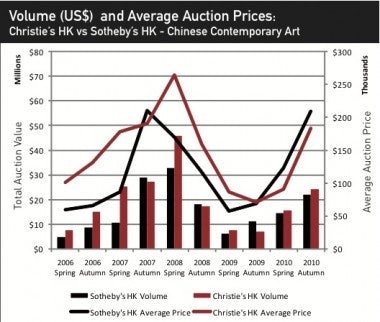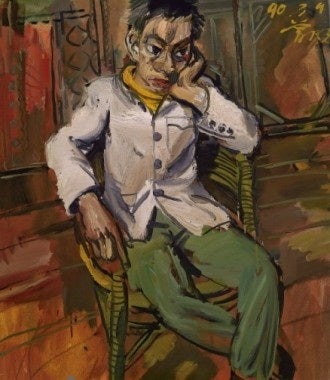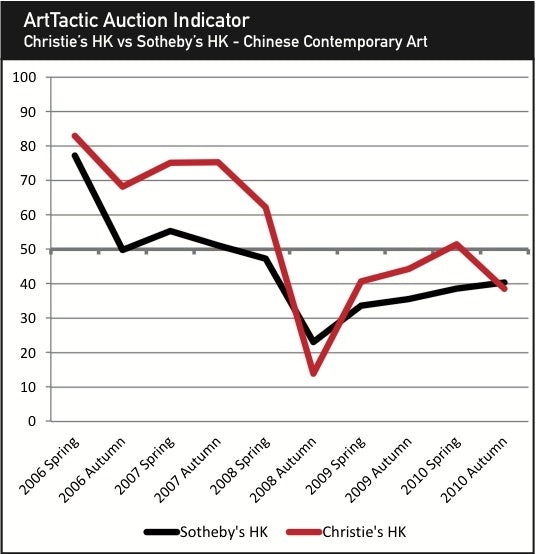Data Shows The Chinese Art Market Is Experiencing A Second Boom - Strongly Supported By Regional Buyers#

ArtTactic's newest report on the Chinese art market is being released this week, and after taking a look at an advance copy sent to Jing Daily, we can confirm that the Chinese art market appears to be in the midst of a "second boom." However, unlike the first boom (2005-2008), which lost steam in the wake of the global financial crisis, the rising prices and shifting trends we're now seeing are driven by Asian -- particularly mainland Chinese -- collectors, rather than the Western "early adopters" who initially boosted the Chinese contemporary art market.
The report calls attention to the recent frenzy in traditional Chinese arts segments -- especially calligraphy, porcelain and ceramics -- best exemplified by the bidding war that broke out between Asian buyers for a Qianlong-era vase earlier this month in London. The vase eventually sold for $83.2 million, a new record for a piece of Chinese art. As ArtTactic points out, the skyrocketing prices for even mediocre antiques or traditional works of art already have art market analysts questioning the sustainability of this surge in prices. However, one good side effect of this buying frenzy -- at least for auction houses -- has been a growing interest among collectors in contemporary art. The recent Christie’s Asian & Chinese 20th Century Art evening sale, held last weekend in Hong Kong, achieved a total of $31,060,900 (excluding premium). This was 8% lower than Christie’s "white glove" sale in spring 2010, previously covered by Jing Daily.
Currently, ArtTactic adds, Christie's and Sotheby's are competing "neck and neck" in Hong Kong, with Christie’s total for Chinese contemporary art only 9.1% higher than the equivalent sales for Sotheby’s. At the recent Christie’s Contemporary Asian Sale, Chinese contemporary art accounted for 89.5% of the total auction value, versus 72.1% for Sotheby’s. Of course, domestic Chinese auction houses haven't missed out on the action, with China Guardian setting a new record with a $620 million sale just last week.

Another interesting finding in the new ArtTactic study is the rising median price of contemporary pieces sold at recent auctions. At last weekend's auctions in Hong Kong, the average auction price for contemporary Chinese art increased to $182,880, more than double that of spring 2010. Reflecting Jing Daily's recent observations on the state of the Chinese collector market, which is to say that new Chinese collectors are willing to pay virtually any price for top-quality works by blue-chip artists, the price segments that saw the strongest interest were works that sold for $100,000 or more, with significant interest in the $100,000-$500,000 price bracket. This price category saw its share of the total increase from 14% to 18%, or in terms of value, from $2.19 million in spring 2010 to $4.35 million in the autumn 2010. This is a significant shift, again powered by domestic Chinese demand and buying patterns.
Perhaps unsurprising, but important nonetheless, is the popularity of Zeng Fanzhi among Chinese collectors. Works by Zeng, who Jing Daily noted last year was named "China's #1 Artist" by the Chinese-language arts portal Artxun, accounted for four out of the top 10 prices at Christie's last weekend, accounting for 27% of the overall sale total. Other artists who have proven popular with Chinese buyers at recent auctions include Mao Xuhui, whose "92 Paternalism" (1992), sold for $1.3 million against a pre-sale estimate of $390,000-$650,000. Zhang Xiaogang also had a good run at Christie's, and despite only having one lot from the "Bloodline" series in the top 10 price list, six lots sold for a total of $2.6 million, with only one painting failing to find a buyer.
Although there were a few high-profile failures at Christie's, most notably Cai Guo-Qiang's “Search for Extraterrestrials” (1997), which didn't meet its reserve, ArtTactic suggests that these surprising results indicate a "strong revival" in the Chinese contemporary art market, adding that "the market remains selective, with a strong focus on certain artists."
Most crucial among ArtTactic's findings is that the Chinese contemporary art market is currently entering a new, uncharted phase, distinct from the first market boom that began in 2005, wherein the dominant buyers are Asian, rather than Western. The study projects that this trend is likely to continue, and will in all likelihood only widen the valuation gap between Chinese artists who appeal more to Western collectors -- such as Ai Weiwei and Zhang Huan -- and those who represent a more "Asian taste," such as Zeng Fanzhi, Liu Ye, and Zhang Xiaogang. This echoes findings from ArtTactic's last report on confidence levels in the Chinese contemporary art market, covered by Jing Daily in September.
Interestingly enough, the artists most popular with Western collectors, specifically Ai Weiwei and Cai Guo-Qiang, topped ArtTactic's artist longevity indicators in the previous study, indicating that the buying trends of Western collectors will remain important even as the tastes of Asian collectors gradually reshape the market.
Concluding the study, ArtTactic adds a note of caution, warning that the surge in art prices may attract more speculators and short-term investors. If the current rate of growth continues, we could be in the early stages of a second bubble in the Chinese contemporary art market, this time inflated by strong Asian demand for high-yielding assets.
